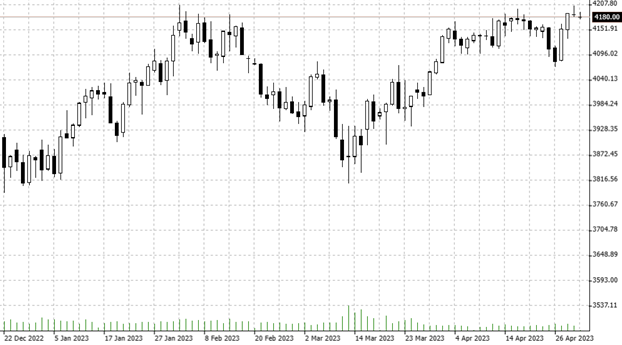

02.05.2023 – History does not repeat itself: unlike 2008, this time the banking crisis appears to have been contained. JPMorgan Chase has taken over the reeling First Republic. The market can now focus on the reporting season – and here, too, things are looking far better than feared so far.
This could have been a fatal conflagration: Had First Republic not found a buyer, a new panic might have broken out. But that’s how the S&P 500 has been working through the banking crisis lately, here the daily chart.

Source: Bernstein Bank GmbH
News just in from the Federal Deposit Insurance Corporation (FDIC): the agency said it had approved the sale to JP Morgan. A half-dozen banks had participated in the bidding process for First Republic, including Citizens Financial and PNC Financial Services, according to insiders.
FDIC steps in after bank run
The purchase may have come at the last second: Earlier last week, First Republic reported a withdrawal of more than $100 billion in customer funds in the first quarter. As a result, the stock crashed on the stock market. The previously planned bailout of the industry had not prevented the bank run: Other banks had pumped some $30 billion into the reeling First Republic. The plunge in the share price was probably the signal for the FDIC to now quickly put its money where its mouth is – the FDIC set a new bailout in motion.
Obviously, the authorities have learned from the disaster in 2008, when two heavyweights, Bear Stearns and Lehman Brothers, toppled over. First Republic is the third U.S. bank to topple in recent weeks as customers pulled their deposits en masse. In March, Silicon Valley Bank and Signature Bank collapsed because of it.
Goldilocks
In any case, the calming of the situation in the banking industry could give the bulls another shove of strength. After all, without disruptive factors from the financial sector, the reporting season could unfold. In any case, the blog “The Market Ear” recently stated that there is a real Goldilocks market. That is to say: everyone is happy and in the best of moods. In any case, the maximum weekly loss in the SPX in the past seven weeks was just minus 0.1 percent.
Furthermore, more than half of the companies in the S&P 500 have reported their first quarter results – and the earnings per share beat rate is 79 percent. We translate: Nearly four-fifths of all companies beat expectations. The earnings surprises were substantial, up 7 percent, he said – and they were in every sector. The beat rate for sales was 73 percent, “The Market Ear” further stated.
Wir meinen: Damit ist also bislang die befürchtete Rezession ausgeblieben. Oder aber die Schätzungen der Analysten waren so pessimistisch, dass es ein Leichtes war, sie zu übertreffen. Das bedeutet nicht, dass es von nun an immer nur bergauf geht. Schon der Budgetstreit in den USA mit der erreichten Verschuldungsgrenze könnte einige Anleger zum Kassemachen einladen. Außerdem weiß man nie, was hinter den Kulissen so alles läuft. Und welche Bank wegen der steigenden Zinsen in Problemen mit dem Neugeschäft steckt. Wir sind gespannt, wie die es an der Wall Street weitergeht – und wünschen erfolgreiche Trades und Investments!
__________________________________________________________________________
The content of this publication is for general information purposes only. In this context, it is neither an individual investment recommendation or advice nor an offer to purchase or sell securities or other financial products. The content in question and all the information contained therein do not in any way replace individual investor- or investment-oriented advice. No reliable forecast or indication for the future is possible with respect to any presentation or information on the present or past performance of the relevant underlying assets. All information and data presented in this publication are based on reliable sources. However, Bernstein Bank does not guarantee that the information and data contained in this publication is up-to-date, correct and complete. Securities traded on the financial markets are subject to price fluctuations. A contract for difference (CFD) is also a financial instrument with leverage effect. Against this backdrop, CFD trading involves a high risk up to the point of total loss and may not be suitable for all investors. Therefore, make sure that you have fully understood all the correlating risks. If necessary, ask for independent advice. CFDs are complex instruments and are associated with the high risk of losing money quickly because of the leverage effect. 68% of retail investor accounts lose money trading CFD with this provider. You should consider whether you understand how CFD work and whether you can afford to take the high risk of losing your money.7
